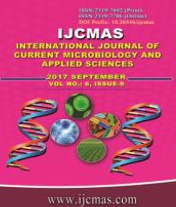


 National Academy of Agricultural Sciences (NAAS)
National Academy of Agricultural Sciences (NAAS)

|
PRINT ISSN : 2319-7692
Online ISSN : 2319-7706 Issues : 12 per year Publisher : Excellent Publishers Email : editorijcmas@gmail.com / submit@ijcmas.com Editor-in-chief: Dr.M.Prakash Index Copernicus ICV 2018: 95.39 NAAS RATING 2020: 5.38 |
A survey was conducted on Swarna cultivar (MTU 7029) of rice during Kharif 2013, 2014, 2015 and 2016 at Nadia district of West Bengal to record the fungal disease and their respective yield loss. Ten diseases (Leaf blast, Sheath blight, Sheath rot, Brown spot, Brown Leaf Spots caused by Curvularia lunata, Stackburn disease, Leaf spot caused by Nigrospora oryzae, Stem rot, Rotting by Choanephora cucurbitarum and False smut) were based on visual observation on Swarna rice cultivar and yield loss due to respective disease was calculated by measuring test weight (gm) of rice grains. Leaf blast was noticed in mild form at Madanpur whereas, Sheath blight were noticed in severe form at Jaguli and Chakdah. Among eight spots (Madanpur, Jaguli, Gayeshpur, Kalyani, Chakdah, Ranaghat, Santipur and Krishnagar) of Nadia district, the disease incidence of sheath rot was recorded maximum at Jaguli and Kalyani, while moderate infection was observed at Chakdah and Santipur. Brown spot was more severe at Chakadah and Jaguli. Mild and trace infection was recorded due to Leaf spot caused by Nigrospora oryzae, stem rot and rotting caused by Choanephora cucurbitarum and the false smut was more severe at Jaguli. Two bio metrological parameters (Temperature and relative humidity) were recorded during Kharif 2013, 2014, 2015 and 2016. The different diseases were favoured by different growth stages of rice.
 |
 |
 |
 |
 |